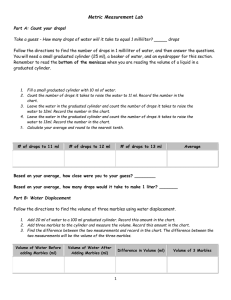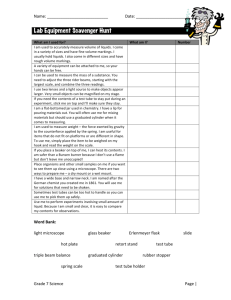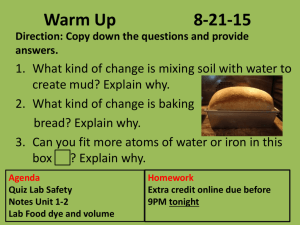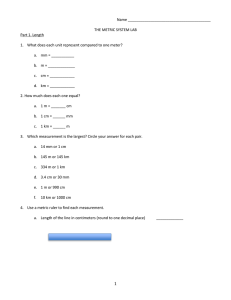Volume Lab - The Science Spot
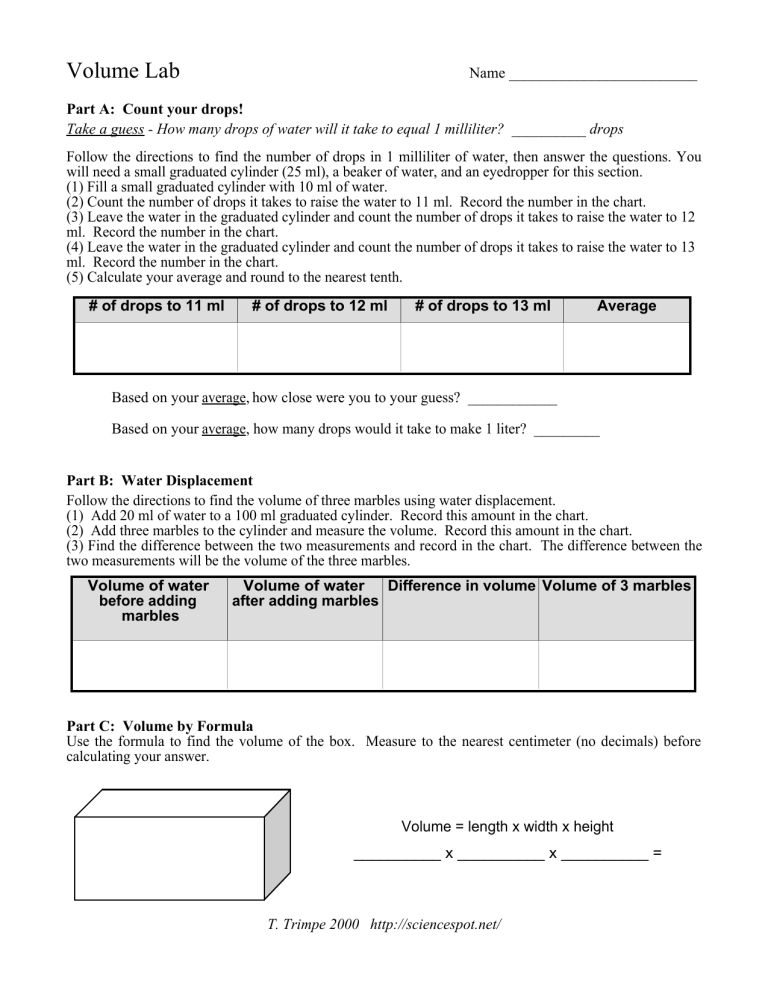
Volume Lab
Name _________________________
Part A: Count your drops!
Take a guess - How many drops of water will it take to equal 1 milliliter? __________ drops
Follow the directions to find the number of drops in 1 milliliter of water, then answer the questions. You will need a small graduated cylinder (25 ml), a beaker of water, and an eyedropper for this section.
(1) Fill a small graduated cylinder with 10 ml of water.
(2) Count the number of drops it takes to raise the water to 11 ml. Record the number in the chart.
(3) Leave the water in the graduated cylinder and count the number of drops it takes to raise the water to 12 ml. Record the number in the chart.
(4) Leave the water in the graduated cylinder and count the number of drops it takes to raise the water to 13 ml. Record the number in the chart.
(5) Calculate your average and round to the nearest tenth.
# of drops to 11 ml # of drops to 12 ml # of drops to 13 ml Average
Based on your average, how close were you to your guess? ____________
Based on your average, how many drops would it take to make 1 liter? _________
Part B: Water Displacement
Follow the directions to find the volume of three marbles using water displacement.
(1) Add 20 ml of water to a 100 ml graduated cylinder. Record this amount in the chart.
(2) Add three marbles to the cylinder and measure the volume. Record this amount in the chart.
(3) Find the difference between the two measurements and record in the chart. The difference between the two measurements will be the volume of the three marbles.
Volume of water before adding marbles
Volume of water after adding marbles
Difference in volume Volume of 3 marbles
Part C: Volume by Formula
Use the formula to find the volume of the box. Measure to the nearest centimeter (no decimals) before calculating your answer.
Volume = length x width x height
__________ x __________ x __________ =
__________
T. Trimpe 2000 http://sciencespot.net/
Part D: Color Challenge
1. Obtain the following items from your teacher:
3 beakers with colored water- 25 ml of each color (red, blue, and yellow)
1 graduated cylinder (25 ml - 50 ml)
1 eyedropper
6 test tubes labeled A, B, C, D, E, and F
2. Perform each step outlined below using accurate measurements.
(1) Measure 17 ml of RED water from the beaker and pour into test tube A.
(2) Measure 21 ml of YELLOW water from the beaker and pour into test tube C.
(3) Measure 22 ml of BLUE water from the beaker and pour into test tube E.
(4) Measure 5 ml of water from test tube A and pour it into test tube B.
(5) Measure 6 ml of water from test tube C and pour it into test tube D.
(6) Measure 8 ml of water from test tube E and pour it into test tube F.
(7) Measure 5 ml of water from test tube C and pour it into test tube B.
(8) Measure 2 ml of water from test tube A and pour it into test tube F.
(9) Measure 4 ml of water from test tube E and pour it into test tube D.
3. Complete the chart.
Test Tube
A
B
C
D
E
F
Color Final Amount (ml)
T. Trimpe 2000 http://sciencespot.net/
Volume Lab Answer Key
Part A: Answers will vary; however, my students usually end up with an average of 20 drops per milliliter.
The biggest problem I encounter is that students count the number of drops to 11 ml. They should fill the cylinder to 10 ml (meniscus is on the 10 ml mark) and count the number of drops it takes to reach 11 ml.
Part B: Answers will vary. My students usually end up with a volume of 5-6 ml for three marbles.
Part C: Students should end up with measurements of 5 cm, 2 cm, and 1 cm if they measure to the nearest centimeter (no decimals). The answer would be 5 x 2 x 1 = 10 cm 3 .
Part D: Students should end up with final measurements of 10 ml in each test tube if they measured carefully for each step. I allow ±0.5 ml for error. The final colors should be A - red, B - orange, C yellow,
D - blue, E - green, and F - purple.
TIP: When mixing the main colors, make all of them dark. It is a good idea to test the colors before the lab to make sure the final results are close to the colors listed above. The purple often ends up as a very dark purple. It does help to hold the test tubes up to a light to determine the final colors.
Safety Rules: After the lab, ask students if anyone has colored hands or papers and relate to lab safety rules. If the water samples were chemicals, colored hands or papers would indicate that the person came in contact with the “chemicals.”
T. Trimpe 2000 http://sciencespot.net/
